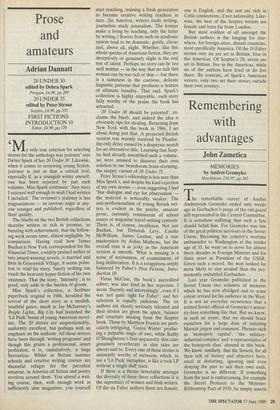Prose and amateurs
Adrian Dannatt
20 UNDER 30 edited by Debra Spark
Penguin, f4.99, pp.269
20 UNDER 35 edited by Peter Straus
Sceptre, £4.99, pp.335
FIRST FICTIONS: INTRODUCTION 10
Faber, f4.99, pp.179
y only true criterion for selecting stories for the anthology was jealousy' says Debra Spark of her 20 Under 30. Likewise, when it comes to reviewing young fiction, jealousy is just as fine a critical tool, especially if, as a youngish writer oneself, one has been rejected by just such volumes. Miss Spark continues: 'Any story I enjoyed well enough to wish I had written I included.' The reviewer's jealousy is less magnanimous — an envious angst at any- one younger and published, regardless of their quality. The blurbs on the two British collections describe writers so rich in promise, so bursting with achievement, that the follow- ing work seems tame, almost negligible, by comparison. Having read how James Buchan is New York correspondent for the Financial Times, a widely-praised author of two award-winning novels, is married and lives in Greenwich Village, it seems point- less to read his story. Surely nothing can touch the heavenly hyper-fiction of his own existence. That the story, 'Intensity', is so good, only adds to the burden of gloom. Miss Spark's collection, a Scribner paperback original in 1986, heralded the revival of the short story as a modish, youthful genre, much as Jay McInerney's Bright Lights, Big City had launched the 'Lit Pack' boom of young American novel- ists. The 20 stories are unquestionably, uniformly excellent, but perhaps with an emphasis on the uniform. All these writers have been through 'writing-programs' and though this grants a professional, smart perfection, it is, cumulatively, a tinge flavourless. Whilst in Britain summer schools and creative writing courses are shameful refuges for the parochial amateur, in America all fiction and poetry revolves around them. You attend a writ- ing course, then, with enough work in sufficiently slim magazines, you yourself start teaching, training a fresh generation to become creative writing teachers in turn. (In America, writers study writing, journalists study journalism. The former make a living by teaching, only the latter by writing.) Stories from such an academic system tend to be domestic, gentle, clever and, above all, slight. Whether, like this whole species of American fiction, they are deceptively or genuinely slight is the real test of talent. Perhaps no story can be too well written — in the way that no rich thin woman can be too rich or thin — but there is a sameness in the cautious, delicate linguistic patterns that produces a texture of ultimate banality. That said, Spark's collection is highly enjoyable, each story fully worthy of the praise the book has attracted.
'20 Under 30 should be patented', ex- claims the blurb, and indeed the idea is obviously ripe for stealing. Returning from New York with the book in 1986, I set about doing just that. A projected British version was warmly received by Picador, the only delay caused by a desperate search for an alternative title. Learning that Scep- tre had already assembled such a volume, we were amused to discover their own solution to our boardroom brain-storming, the snappy variant of 20 Under 35.
Peter Straus's editorship is less sure than Miss Spark's, and despite his kind rejection of my own stories — even suggesting I had 'fine dialogue and eye for observation' the material is noticeably weaker. The anti-professionalism of young British wri- ters is evident in the patchy, amateur prose, curiously reminiscent of school essays or magazine travel-writing contests. There is, of course, excellence. Not just Buchan, but Deborah Levy, Candia McWilliam, James Lasdun, and a true masterpiece by Aidan Mathews, but the overall tone is as jerky as the American version is smooth. What is missing is a sense of seriousness, of commitment, of long deliberation. It is a scrappiness amply balanced by Faber's First Fictions, Intro- duction 10.
Fiona McCrae, the book's uncredited editor, was also kind in her rejection. I wrote 'fluently and interestingly', even if I was 'not quite right for Faber', and her selection is equally judicious. The six authors are clearly seriously talented and their stories are given the space, balance and structure missing from the Sceptre book. Those by Matthew Francis are parti- cularly intriguing, 'Green Winter' produc- ing a palpable tingle of awe, while Kathy O'Shaughnessy's four apparently slim tales genuinely reverberate as slim tales are always said to. Every one of these stories is eminently worthy of inclusion, which, to use a 'Lit Pack' metaphor, is like a rock LP without a single duff track.
If there is a theme detectable amongst the diversity of these three collections it is the supremacy of women and Irish writers. Of the six Faber authors three are female, one is English, and the rest are rich in Celtic connections, if not nationality. Like- wise, the best of the Sceptre writers are female and born far from London.
But most evident of all amongst the British authors is the longing for else- where, for foreign cities, distant countries, most specifically America. Of the 19 Faber stories only six are set in Britain, four in the Americas. Of Sceptre's 20, seven are set in Britain, five in the Americas, while six of the authors have lived or do live there. By contrast, of Spark's American writers, only two set their stories outside their own country.


















































 Previous page
Previous page